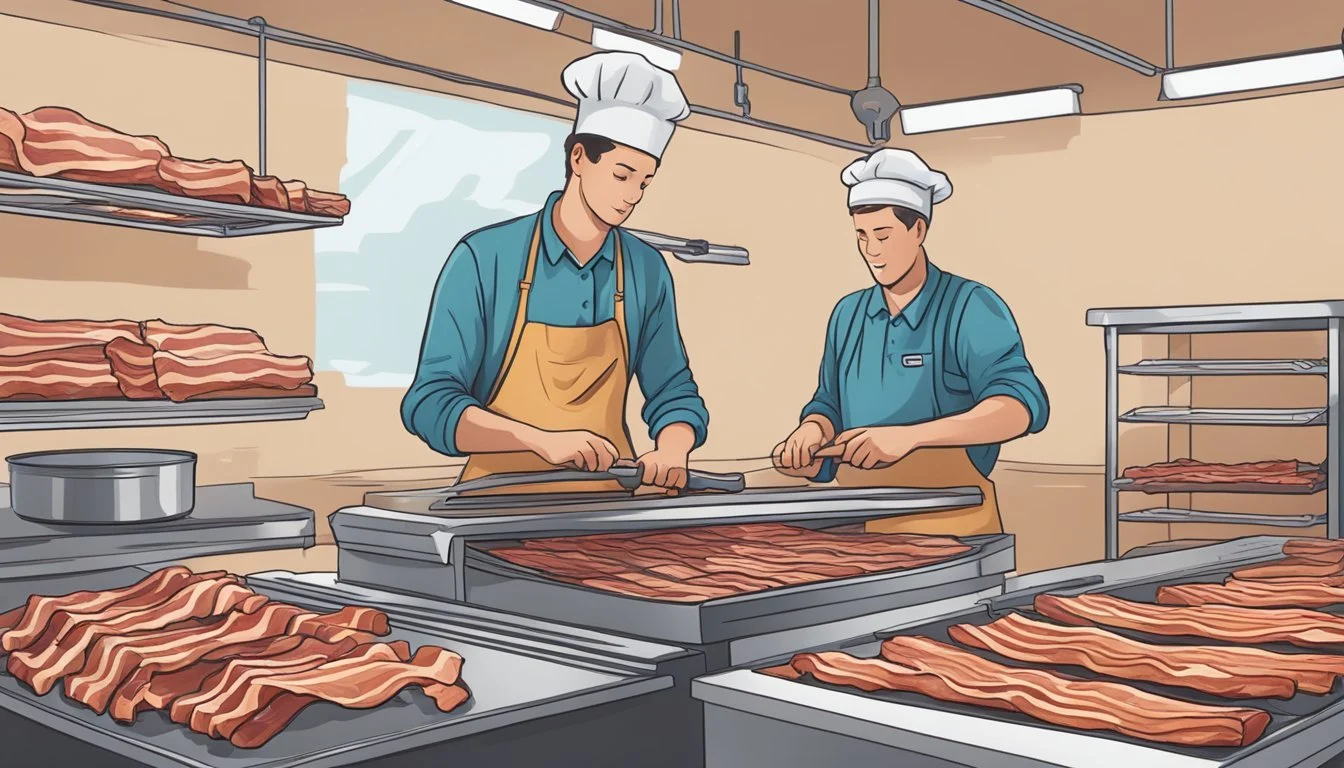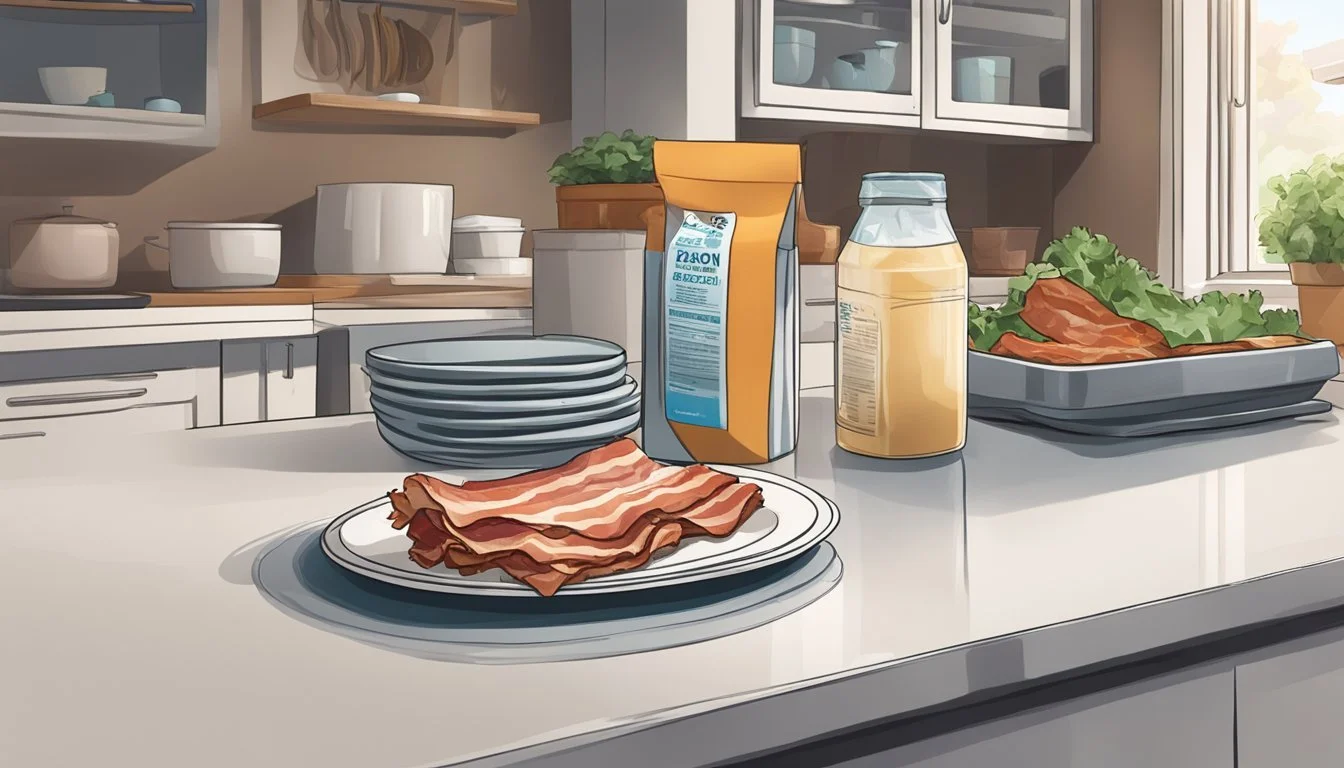Do I Have to Refrigerate Bacon?
Guidelines for Proper Storage
When it comes to bacon, proper storage is key for maintaining its freshness and flavor. Whether it's cooked or uncooked, bacon is a perishable food that contains protein and fat, both of which are susceptible to bacterial growth if not stored correctly. To ensure the safety and quality of bacon, refrigeration is important. Cooked bacon should be placed in the refrigerator if it won’t be eaten immediately. It’s advisable to store it in an airtight container or wrapped tightly in aluminum foil or plastic wrap to maximize freshness.
Refrigerating bacon slows down the growth of bacteria. The cool environment of a refrigerator, typically set below 40°F (4°C), helps to preserve the cooked bacon and extend its shelf life. In general, refrigerated cooked bacon can keep its desirable qualities for about 4 to 5 days. However, to avoid any potential spoilage or foodborne illness, bacon should not be left out at room temperature for more than two hours.
For those who wish to store bacon for an extended period, freezing is an option. Cooked bacon freezes well, and when stored properly in airtight containers or freezer bags, it can last up to six weeks. The bacon should be thawed in the refrigerator and then reheated to ensure it’s heated through to the ideal temperature, which also helps restore its crispness before serving.
Understanding Bacon Preservation
When it comes to bacon preservation, two critical aspects require our attention: minimizing bacterial growth to ensure food safety and understanding how preservation varies depending on bacon type.
Bacteria and Food Safety
Bacteria, such as Salmonella and Listeria, are of paramount concern when preserving bacon. These microorganisms can thrive on the fat and protein within bacon, necessitating proper storage to prevent foodborne illnesses. Food safety practices dictate that cooked bacon must be refrigerated to limit bacterial growth. The optimal temperature is at or below 40°F (4°C). Even vacuum-sealed, fully cooked bacon can benefit from refrigeration to extend shelf life and maintain quality.
Prevention Methods:
Refrigerate promptly after cooking
Store in airtight containers or sealed bags
Observe use-by dates provided by manufacturers
Types of Bacon: From Raw to Pre-Cooked
The storage needs of bacon vary significantly by type.
Raw Bacon: This category includes cuts of bacon that have been dry-cured or wet-cured with additives to enhance flavor and preservation. Refrigeration is essential for raw bacon, which should not be left at room temperature.
Pre-Cooked Bacon: Often more shelf-stable due to additional processing, pre-cooked bacon has a longer shelf life than raw. However, once opened, it too should be stored in the refrigerator.
Dry-Cured Bacon: With less moisture content due to the curing process, it often has a longer shelf life but should still be refrigerated after opening.
Additives: Preservatives in pre-cooked bacon contribute to a longer shelf life but do not eliminate the necessity for refrigeration after opening.
Shelf-Stable Bacon: Certain types of cooked bacon are treated to be shelf-stable, requiring refrigeration only after opening. These products are best stored at temperatures at or below 85°F (29°C).
Type Condition Refrigeration Needed Special Considerations Raw Bacon Unopened Yes Keep refrigerated, use by date Pre-Cooked Unopened Not always Refrigerate after opening Cooked Bacon After cooking Yes Airtight storage, monitor use-by Shelf-Stable Unopened No Store cool, refrigerate after use
It is the combination of temperature control, airtight storage, and attention to food safety practices that ensures the safe preservation of various types of bacon.
Refrigerating Bacon
The proper storage of bacon is essential in preserving its flavor and safety. Whether it is raw or cooked, bacon requires specific refrigeration practices to extend its shelf life and prevent bacterial growth.
Storing Raw Bacon
After purchasing raw bacon, it should be placed in the refrigerator as soon as possible. In its original packaging, raw bacon can typically be kept safely for up to two weeks in the refrigerator. If the package of bacon is opened, it is advisable to use it within one week. To ensure optimal freshness:
Keep it stored in its original packaging if unopened.
Seal it in an airtight container or wrap it with plastic wrap or aluminum foil if opened.
Storing Cooked Bacon
Once bacon is cooked, storing it properly becomes crucial to maintain its taste and edibility. Cooked bacon should be refrigerated within two hours of cooking and will generally have a shelf life of four to five days when stored correctly. To store cooked bacon:
Cool the bacon to room temperature.
Place the bacon in a shallow airtight container or wrap it tightly in plastic or foil.
For individual portions, separate slices with parchment paper.
Freezing Bacon
For long-term storage, freezing bacon is an excellent option. Both raw and cooked bacon can be frozen to significantly extend its usability. While frozen cooked bacon can last for up to six months, raw bacon can typically be frozen for up to eight months. Here are the steps to freeze bacon properly:
Raw bacon: Wrap individual portions in plastic wrap, followed by aluminum foil, and place them in an airtight container or a heavy-duty freezer bag.
Cooked bacon: After cooling, wrap the bacon in parchment, then in plastic, and finally place it into a freezer bag or container.
When using frozen bacon, it is recommended to label the freezing date. For best quality, thaw bacon in the refrigerator before usage.
Handling and Preparing Bacon
When dealing with bacon, proper handling and preparation ensure that the meat retains its texture and flavor, whether it's being thawed or reheated.
Thawing Frozen Bacon
To thaw frozen bacon, one should transfer it from the freezer to the refrigerator at least 24 hours before it's intended to be cooked. This gradual thawing method allows the bacon to retain its texture and minimizes the risk of bacterial growth. For a quicker thaw, one can use a microwave but should follow the appliance's instructions for defrosting meat to avoid partial cooking.
Reheating Bacon
To reheat cooked bacon, whether it was stored in the refrigerator or freezer, there are three main methods one might use:
Oven: Preheat the oven to 350°F (175°C). Place the bacon on a baking sheet lined with aluminum foil or parchment paper for easy clean-up, and heat it until warm and crisp, typically for about 10-15 minutes.
Skillet: Heat a skillet over medium heat, and add the bacon. Cook for a few minutes on each side until it's heated through and crispy. No additional fat is needed as the bacon already contains fat that will help it crisp.
Microwave: Sandwich bacon between paper towels on a microwave-safe plate. Heat it on high power for about 20-30 seconds per slice. The paper towels absorb excess fat and moisture, resulting in a better texture.
Each method has its own advantages and can be selected based on the desired crispness and convenience.
Duration and Freshness Indicators
When it comes to bacon, understanding its shelf life and the signs of spoilage is crucial for safety and taste. This section provides clear guides on expiration dates, storage practices, and recognizing when bacon should no longer be consumed.
Expiration Date and Freshness
Unopened bacon typically lasts up to two weeks in the refrigerator past the printed expiration date, assuming the package is stored properly. Opened bacon, however, should be consumed within a week. The shelf life extends significantly if bacon is stored in the freezer – up to six months for both opened and unopened packages.
Here is a simple guide to bacon's shelf life:
Bacon Type Refrigerator Freezer Unopened regular bacon Up to 2 weeks 6 months Opened regular bacon Up to 1 week 6 months Unopened turkey bacon/pancetta Up to 2 weeks 6 months Opened turkey bacon/pancetta Up to 1 week 6 months
Signs of Spoilage
Bacon that has gone bad will display visible indicators of spoilage. Consumers should look for:
A color change from natural pink to grey.
A slimy texture developing on the surface.
The presence of mold is a definitive sign that the bacon must be discarded.
A rancid or off flavor; spoiled bacon will not taste as it should.
When in doubt, it is best to err on the side of caution and discard bacon that shows any of the above signs of spoilage. Eating spoiled bacon can lead to foodborne illnesses, thus it should never be used in dishes, including salads, even if it's going to be cooked.
Practical Tips for Bacon Storage
Storing bacon correctly is essential for maintaining its quality and safety. The following subsections offer specific guidance on how to keep bacon in top condition through proper packaging and labeling.
Proper Packaging for Bacon
For uncooked bacon, keeping it in its original packaging is usually sufficient until its first use. After opening, it's best to wrap the bacon in plastic wrap, aluminum foil, or place it in an airtight container to prevent the bacon from drying out and absorbing flavors from other foods in the refrigerator. One can also store bacon in a plastic bag with as much air removed as possible to retain its freshness.
Cooked bacon should be cooled at room temperature on a wire rack and then blotted with paper towels to remove excess grease. This preparation prevents the bacon from becoming soggy. It should then be wrapped in paper towels to absorb any residual grease before placing it in an airtight container or plastic bag. If one chooses to freeze cooked bacon, the same preparation applies, and individual portions can be wrapped for ease of use.
Refrigerated bacon should be used within 5 days.
Frozen bacon can last up to 6 weeks without significant quality loss.
Labeling for Future Reference
When storing bacon for later use, it's important to label the plastic bag or airtight container with the date of storage. Labeling assists with inventory management and ensures that bacon is used within an ideal timeframe to prevent spoilage and waste. Using a permanent marker, note the date and whether the bacon is cooked or uncooked to avoid any confusion when retrieving it from the storage:
Label example: "Cooked bacon - May 18, 2024"
For freezer storage, indicating the date is especially crucial to keep track of the bacon's longevity. Frozen bacon should be thawed in the refrigerator or cooked directly from the freezer to ensure food safety.
Creative Uses for Leftover Bacon
Leftover bacon need not go to waste; it can enhance the flavor and add texture to a variety of dishes. With creativity, one can repurpose this ingredient, ensuring that no part of the bacon is left behind.
Incorporating Bacon into Recipes
Bacon's rich flavor makes it a versatile addition to many recipes. For a hearty breakfast, one can chop the bacon and stir it into scrambled eggs, or layer it in a bacon sandwich for a savory twist. In lunch and dinner dishes, adding chopped bacon to a BLT sandwich elevates the classic with its smoky taste. In consideration of versatility, a chef might also weave bacon into casseroles or pasta dishes, capitalizing on its ability to infuse meals with depth of flavor.
Making Bacon Bits and Additions
Leftover bacon can be transformed into bacon bits—a crunchy, flavor-packed garnish. To create these bits:
Chop the bacon into small pieces
Cook until crisp
Drain on paper towels
Bacon bits can be sprinkled over salads, adding a delectable crunch and rich taste. Alternatively, chefs might use bacon as an addition to baked goods such as savory scones or cornbread, where its salty punch contrasts the sweetness and complements the textures within these pastries.






